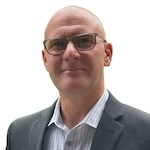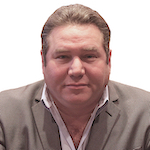As soon as an electroplating shop mentions new or upgraded lines to Renny Fritz, that is when the questions start pouring out of him.
 Renny Fritz“Why are they looking for a new line?” Fritz says. “Are they currently doing the process now? Are they looking to bring it in a house? I have to understand their expectations, because there's a lot of factors you have to consider.”
Renny Fritz“Why are they looking for a new line?” Fritz says. “Are they currently doing the process now? Are they looking to bring it in a house? I have to understand their expectations, because there's a lot of factors you have to consider.”
Fritz, who recently became a Technical Sales Specialist at Carlisle Fluid Technologies, but for years was the Application Sales Manager at Koch Jessup Systems, a division of George Koch Sons. He got his start as a welder at Jessup in 1990, and has spent the better part of his 33 years in the business helping build or upgrade systems for finishers across the U.S.
When he begins a conversation with a finishing shop on either installing a new line or upgrading an existing one, Fritz almost becomes a pseudo-psychologist to get inside the thinking process of the customer.
“A lot of shops have an idea of what they want, but I have to ask ‘why’ are they looking to do it?” he says. “Most are doing it because they are looking for efficiency, repeatability, and all the things that address automation. Basically, you need to understand what they're seeking for throughput.”
Numerous Reasons to Add or Rebuild
 At right, Kerry Behnke, Pro Plating’s Zinc Business Team Manager, meets with engineers from George Koch Sons to discuss planning for their new line. For some shops, the reasons to expand their operations and add finishing lines are to meet growing customer demand. For others, it is maybe refurbishing and upgrading their existing line to change out motors and hoists to get improved efficiencies out of lines that could be two to three decades old.
At right, Kerry Behnke, Pro Plating’s Zinc Business Team Manager, meets with engineers from George Koch Sons to discuss planning for their new line. For some shops, the reasons to expand their operations and add finishing lines are to meet growing customer demand. For others, it is maybe refurbishing and upgrading their existing line to change out motors and hoists to get improved efficiencies out of lines that could be two to three decades old.
Either way, getting a design and installation done correctly — with proper automation and controls — is imperative to a long lasting process line that will hold up to future demands.
“If you are designing a plating or conversion coating process line, you need to make the most of the opportunity,” says Venkat Raja, President and Founder of Advint in Ontario, Canada, which advises surface finishing companies
“A well-designed plating process line in most cases would only require about 20% changes to its features in the operations phase in the long term,” he says. “In reality, the required changes in the operations phase are seldom lesser than 20%. And these changes are expensive, time-consuming, and in most cases the problem and the positive benefits are unknown.”
80% of Shops Planned new Processes in 2023
And after turmoil during the pandemic a few years ago, shops are seeing an explosion of new business in the coming years.
- A survey by FinishingAndCoating.com found that 58% of all shops say they expected to see sales in an already busy industry jump by more than 10% in 2023. More than 18% of all shops surveyed expected at least a 20% increase in business this year, which meant more throughout from the facilities.
- And this was after about half of all shops surveyed said they saw a 20% or higher increase in sales in 2022 compared to 2021.
- Roughly 90% of all shops surveyed by FinishingAndCoating.com say they planned to spend money on new capital equipment purchases in 2023 as they try to maintain their current equipment and add new equipment where they can fit it in.
- More than 49% of shops say they are upgrading their existing lines to add new motors, hoists, or PLC systems. About 25% say they are spending big cash to add new lines to their operations. Around 9% report they are expanding the size of the facility, and 8% say they are upgrading their wastewater treatment plants.
- Of the shops who do plan to spend money on capital improvements, roughly 14% say they will spend in excess of $1 million on projects to improve their equipment. About 57% say they have budgeted between $100,000 and $500,000 on the projects in 2023, and more than 16% report they will spend at least $75,000 on capital projects.
- All totaled, more than 82% of shops say they plan to add a new process in 2023 to meet the growing demand from customers.
WI’s Professional Plating Spending Millions on New Lines
 Professional Plating is undergoing $9.5 million expansion project on add a pair of new finishing lines.Expansion has been the case in Brillion, Wisconsin for Professional Plating, which is undergoing $9.5 million expansion project on add a pair of new finishing lines. The company will invest over $4 million in a new zinc barrel line that will be online by the end of 2023, the second zinc barrel line that will be operational in their facility.
Professional Plating is undergoing $9.5 million expansion project on add a pair of new finishing lines.Expansion has been the case in Brillion, Wisconsin for Professional Plating, which is undergoing $9.5 million expansion project on add a pair of new finishing lines. The company will invest over $4 million in a new zinc barrel line that will be online by the end of 2023, the second zinc barrel line that will be operational in their facility.
Professional Plating is also spending $5.3 million on a new epoxy electrocoat line to replace its present equipment. That equipment is planned to be operational in July 2024.
General Manager Larry Dietz says the company spent $4.3 million on a new zinc plating line that was christened in 2022, and they also had line expansions in 2016 and again in 2018. Over the past decade, Professional Plating’s owners have invested nearly $20 million in adding lines, upgrading facilities for its team members, and investing in technology and software.
Surprisingly, Dietz says there is no master plan that they are working from.
“You work with your installer and they are going to give you suggestions, then internally you probably put tape on the floor and do all kinds of things in different configurations to figure out which way the floor works best."
“We don't honestly have a long-term capital plan,” Dietz says. “Because we are a job shop, it really depends on customers a lot of times, and there is gut feeling when we add more equipment.”
For example, Professional Plating added 60,000 square feet of new space in 2009 at the height of a recession, but felt they needed the additional capacity and wanted to bring work they were sending out back inside. That line quickly filled in a short time, which had them adding more space soon thereafter. They added another 60,000 square feet in 2016, and that line was running at capacity quickly.
Build a Line or Refurbish an Existing Line?
 Kerry BehnkeKerry Behnke, Pro Plating’s Zinc Business Team Manager, says they have two trains of thought when looking at expansion or upgrades: whether you have new space to build a line, or if you need to retrofit an existing facility.
Kerry BehnkeKerry Behnke, Pro Plating’s Zinc Business Team Manager, says they have two trains of thought when looking at expansion or upgrades: whether you have new space to build a line, or if you need to retrofit an existing facility.
“We were fortunate enough in 2015 when we started one of the larger rack lines that we had expanded the building,” Behnke says. “We started from a blank space, and we knew what that space was size-wise and how the machine would fit in there. That's a pretty simple thing to do.”
Where it takes a little bit more planning, she says, is when you are replacing a line that was decommissioned a few years ago, and now you have to fit it in that existing space.
“That becomes a little bit more complicated,” Behnke says. “You work with your installer and they are going to give you suggestions, then internally you probably put tape on the floor and do all kinds of things in different configurations to figure out which way the floor works best. But you would never make any of those decisions all by yourself. You still need the Kochs of the world to come in and say, ‘Yep, you have enough floor to roof space, and you have enough back and forth space.’ You need their input just as much about how it's going to work.”
Plan Ahead as Much as Possible
 Over the past decade, Professional Plating’s owners have invested nearly $20 million in adding lines, upgrading facilities for its team members, and investing in technology and software.Fritz says planning as far ahead as possible will make the design and installation of new equipment — as well as retrofits — come out as smoothly as possible. For one, it make take close to a year to get a project completed from concept the commissioning, where pre-pandemic it was half of that.
Over the past decade, Professional Plating’s owners have invested nearly $20 million in adding lines, upgrading facilities for its team members, and investing in technology and software.Fritz says planning as far ahead as possible will make the design and installation of new equipment — as well as retrofits — come out as smoothly as possible. For one, it make take close to a year to get a project completed from concept the commissioning, where pre-pandemic it was half of that.
“We are probably right around 11 months,” he says. “And that's not because I can't build equipment; it's because I can't get some control devices that are out there, such as your PLCs and your control modules.”
One of the first questions that Fritz asks: is this a new process to the shop, or has the facility performed this type of operation before? And over the past few years, he says the work that they have been performing has been split evenly in new lines and refurbishing existing processes with newer equipment and systems.
“It's usually a capacity issue, where they are taking on additional work so they need that capacity,” Fritz says. “The line us old, and it doesn't have all the advanced features today. It was probably a line that was built and they wish they would have done it right the first time.”
Saporito Finishing Drops $1 Million on Refurbished Line
 Jeff LoganChicago’s Saporito Finishing has invested heavily in newer, more automated equipment to help alleviate the reliance on its workforce. In 2022, it commissioned its refurbished automatic zinc rack plating line that now features newer PLC controls and a programable computer HMI interface to allow for a wide variety of cycles to support a vast array of finishing recipes.
Jeff LoganChicago’s Saporito Finishing has invested heavily in newer, more automated equipment to help alleviate the reliance on its workforce. In 2022, it commissioned its refurbished automatic zinc rack plating line that now features newer PLC controls and a programable computer HMI interface to allow for a wide variety of cycles to support a vast array of finishing recipes.
Saporito President Jeff Logan says the computer system also records process information and exports the data to a database that can be reviewed anytime, anywhere, providing objective process parameter documentation in real time.
Logan says the line capacity was upgraded to 1,150 pounds, allowing for zinc plating of very heavy parts. The overall project came in at just under $1,000,000, but the results of the capital project include improvements in quality, repeatability, reliability, and turnaround; reduced downtime for repairs and maintenance; increased capacity to support the growth of our customers.
 Saporito spent just under $1,000,000 on upgrading an older line, and the results included improvements in quality.“Several additional tanks were added to the line extending the footprint to over 100 feet,” Logan says, adding that work bars, racks, and saddles were all redesigned and upgraded to provide greater uniformity across the entire load package reducing variation in coating thickness while improving overall plating quality.
Saporito spent just under $1,000,000 on upgrading an older line, and the results included improvements in quality.“Several additional tanks were added to the line extending the footprint to over 100 feet,” Logan says, adding that work bars, racks, and saddles were all redesigned and upgraded to provide greater uniformity across the entire load package reducing variation in coating thickness while improving overall plating quality.
Upgrades were also made on the hoists to safeguard customer hardware, including an ultrasonic carrier detection system that prevents line crashes, enhancing the protection of customer parts in the process.
Designing the New Line’s Footprint
The design of a new line or upgrade usually takes about 30% of the one-year time frame as engineers look at what needs to go into the space, and then must figure out how to make it fit and work properly. Many design and install companies now use 2D and 3D computerized software to help lay out the lines, and to show shop owners how it will all work.
Fritz says there are many contingencies that go into designing the footprint.
“What really decides what your footprint is going to be basically is the work envelope and the size,” he says. “It’s the size of the whole machine based on the process, as well as other devices such as ventilation, wastewater treatment, RO or DI water. You need areas for rectifier, and then you need your chemical metering. It’s a lot of components.”
“Predicting a production capability on most lines on a long term, particularly for a job shop, is tough.”
Raja says on a metal finishing processing line, choosing a rectifier with correct technical specifications and capacity based on production capability is very important.
“Predicting a production capability on most lines on a long term, particularly for a job shop, is tough,” Raja says. “However, a correct choice on the capacity of a rectifier and on technical specifications will turn errors to account on a process performance.”
Wastewater treatment system usually come in standard designs such as 30-feet by 50-feet of floorspace, but sometimes the area it is going in – or lack thereof — might require some additional engineering.
“You can be creative with wastewater,” Fritz says. “Maybe you make it skinny and long and maybe it's not as tall but it's short and has a couple more vessels. You can be very creative in the wastewater treatment.”
Making Room for All Accessory Equipment and Needs
 “There needs to be an understanding of how you're going to feed the line, and how is the work coming and exiting the machine,” Fritz says. Once a footprint for the line and accessory needs — ventilation, wastewater, rectifiers — is worked out, there are other considerations that must be engineered on paper and computer first before installation begins. There needs to be space for chemical totes and other items, but more importantly there needs to be a design system in place for how the line will be fed parts and also how parts will be pulled from the line.
“There needs to be an understanding of how you're going to feed the line, and how is the work coming and exiting the machine,” Fritz says. Once a footprint for the line and accessory needs — ventilation, wastewater, rectifiers — is worked out, there are other considerations that must be engineered on paper and computer first before installation begins. There needs to be space for chemical totes and other items, but more importantly there needs to be a design system in place for how the line will be fed parts and also how parts will be pulled from the line.
“There needs to be an understanding of how you're going to feed the line, and how is the work coming and exiting the machine,” Fritz says. “When you design the machine, are we loading and loading from one end? Are we loading it one end and exit it out the other, which I find that a lot in Mexico. It depends on your plan, and you can do either. Usually it makes more production sense for operators to have it on one end, but it's not that case for everyone.”
The biggest changes that have affected designing and installing new lines is the advancements in the control systems that better automate the line processes, such as a programmable logic controller, or PLC.
No one knows that more than Navya Venkateshaiah, PhD., who wrote her thesis in 2022 for a graduate degree at the University of Wolverhampton on “Electroplating Process Plant Automation and Management Using Emerging Automation and Communications Technologies.”
Venkateshaiah says maintenance of the optimum condition of the electroplating process solution is vital to achieving good product quality and meeting production schedules.
“However, this is a complex task requiring real-time monitoring and control of numerous tanks and process stages and operations on the production line in an electroplating plant,” she says.
Monitoring and Control of Hoist System are Vital
 Monitoring and control of the hoist system are vital, and computerization provides real-time information about the sensors which are located to stop at the right position.For example, Venkateshaiah says monitoring and control of the hoist system are vital, and computerization provides real-time information about the sensors which are located to stop at the right position. In doing her research for her doctorate, Venkateshaiah says many shops have not adequately automated their systems, which is why many need to either upgrade and refurbish their lines, or tear out and build new ones.
Monitoring and control of the hoist system are vital, and computerization provides real-time information about the sensors which are located to stop at the right position.For example, Venkateshaiah says monitoring and control of the hoist system are vital, and computerization provides real-time information about the sensors which are located to stop at the right position. In doing her research for her doctorate, Venkateshaiah says many shops have not adequately automated their systems, which is why many need to either upgrade and refurbish their lines, or tear out and build new ones.
“The electroplating process industry is currently facing some challenging process control problems in their production plant due to an insufficient level of automation being applied in the industry,” she says. “The control is largely manual, and the monitoring of both plant and processes is ad hoc.”
Venkateshaiah says she discovered that many other variables such as solution density, ions concentration, and current supplied to the plating solutions are not always monitored and controlled.
“It is vital to maintain all the solution parameters to the required range,” she says. “Even slight changes in any of the parameters can result in the rejection of the plated product.”
Fritz says that many in the industry have been using PLC to control variable frequency drive (VFD) for motor speed control for several years, but that because of the nature of the electroplating industry, some are skeptical to place too many automation devices tankside.
“The automation has pretty much stayed the same with control technology, and we are using new things here and there,” he says. “But we are very skeptical and we don't jump right into new things because this is a corrosive industry, and it can be hard on components and equipment.”
As an example, many shops who are adding new lines or doing major upgrades are locations some rectifiers and controls in completely separate rooms in order to avoid corrosion from denigrating the equipment so quickly.
Determining Project’s Return on Investment
 Jaime MaliszewskiSome shops who are adding or refurbishing lines are able to determine very quickly how much the new system will pay for itself in better throughput, improved quality, and fewer rejects.
Jaime MaliszewskiSome shops who are adding or refurbishing lines are able to determine very quickly how much the new system will pay for itself in better throughput, improved quality, and fewer rejects.
Jaime Maliszewski of Reliable Plating Works and Elite Finishing in Milwaukee spent $600,000 renovated a plating line in 2022, adding new hoists, motors, and software to the line first installed in the early 1980s.
But Maliszewski had already done the math before the first bolt was turned, and knew the updated line will give them 20% more throughput and pay for itself in a year or so.
“We want it to have more advanced systems to increase efficiency, and actually speed up the line a little bit, too,” Maliszewski says. “The breakdowns were happening more often, and we were making a lot of hand moves for new customers and new processes. We had to make some adjustments since the automation couldn’t handle it.”
More importantly, Maliszewski says the line will go from processing 10 bars an hour now to 12 bars an hour on this machine, a 20% increase in throughput.
“There’s a lot of things that were no-brainers for us,” he says. “It’s going to pay for itself in less than a year, probably.
Always a Need for Modernization
 Reliable Plating Works and Elite Finishing in Milwaukee spent $600,000 renovated a plating line in 2022, adding new hoists, motors, and software to the line first installed in the early 1980s.Jeff Dellach, General Manager for Jessup Systems at Koch Finishing Systems, says that many shops have some form of automation on their lines but still should be modernized.
Reliable Plating Works and Elite Finishing in Milwaukee spent $600,000 renovated a plating line in 2022, adding new hoists, motors, and software to the line first installed in the early 1980s.Jeff Dellach, General Manager for Jessup Systems at Koch Finishing Systems, says that many shops have some form of automation on their lines but still should be modernized.
“They have controls that rely on limit switches for positioning and for the transfer, and a lot of two-speed motor applications where it has maximum velocities,” Dellach says. “But you’re tapped out, and you can’t go any faster.”
The new line has variable-frequency drive single-speed motors that he says generally cost the same as a two-speed, but the operator can get much better performance.
While tank immersion times are a big factor in what types of throughput improvements can be made, Dellach says they can make up time and improve cycles with better VFD controls.
“Whether it’s one, two, or three loads, every additional load per hour adds up,” he says. “And at the end of the week, it’s good money. When the light bulb goes on in our customer’s minds, and they realize, ‘Okay, yeah, maybe I’m spending more than I thought I would do this upgrade,’ that payback is there because they’re able to get more loads through with that equipment.”
Visit https://www.proplating.com, https://saporitofinishing.com, https://rpwinc.net, https://kochllc.com, and https://theadvint.com.



































